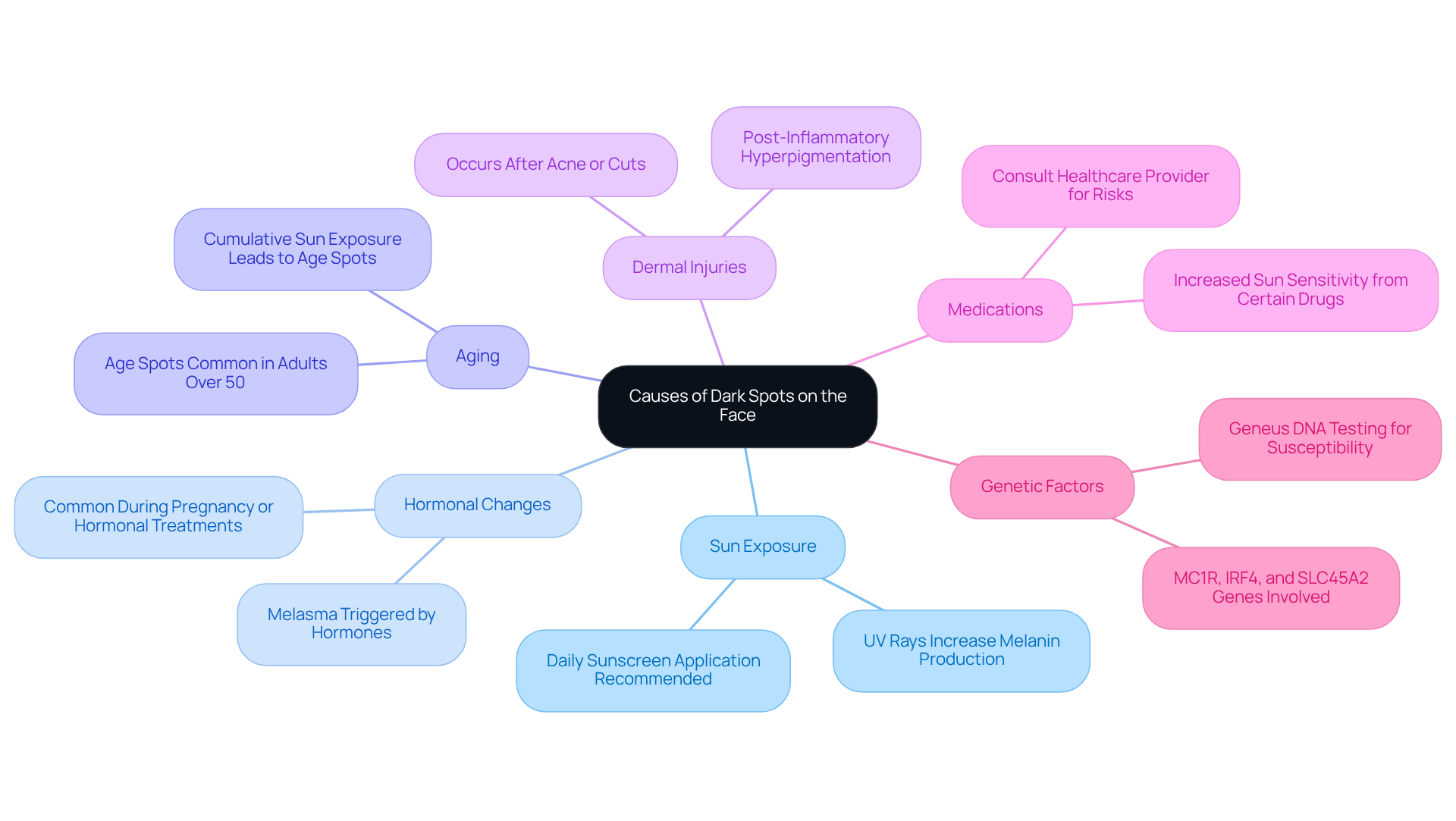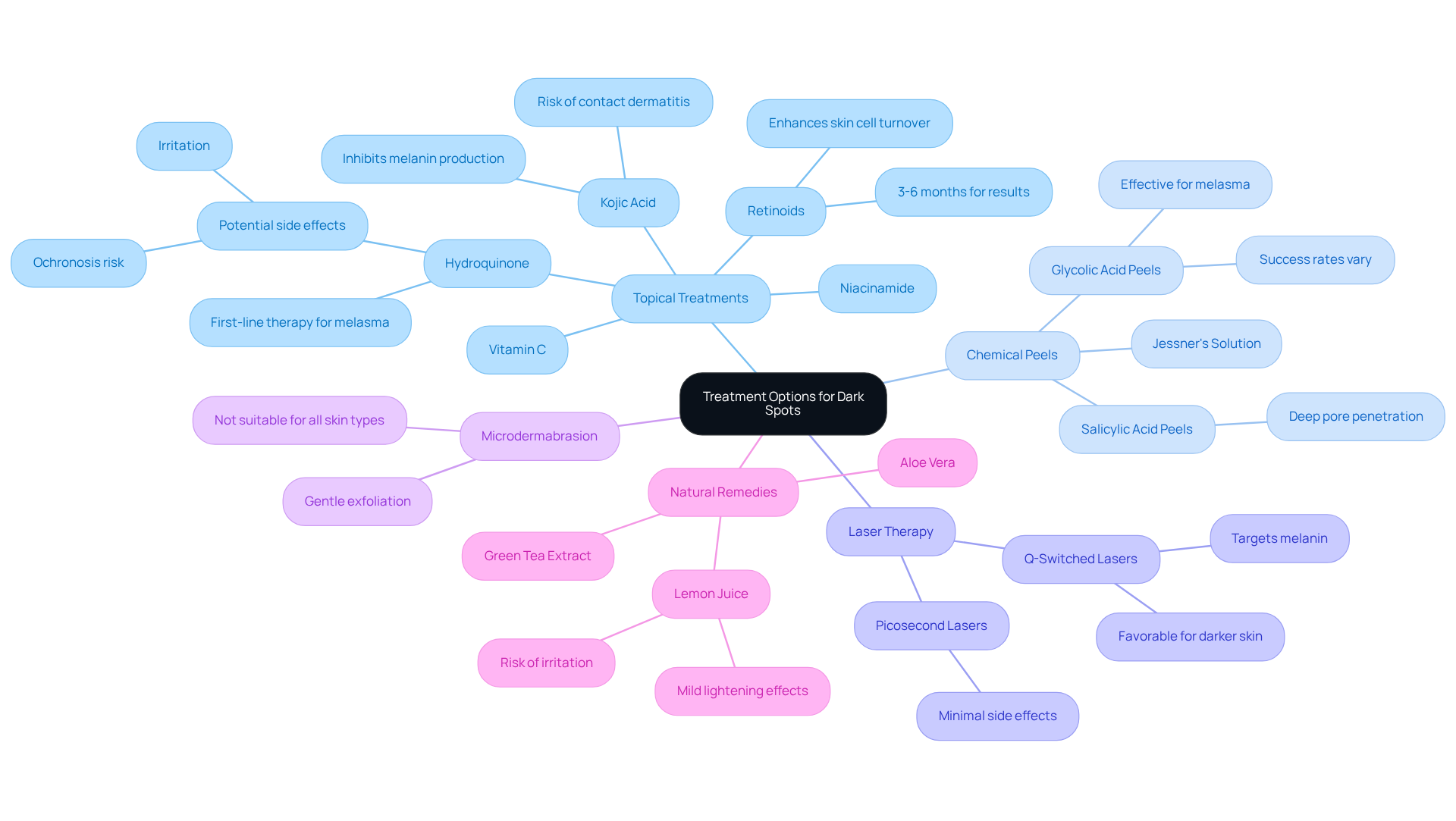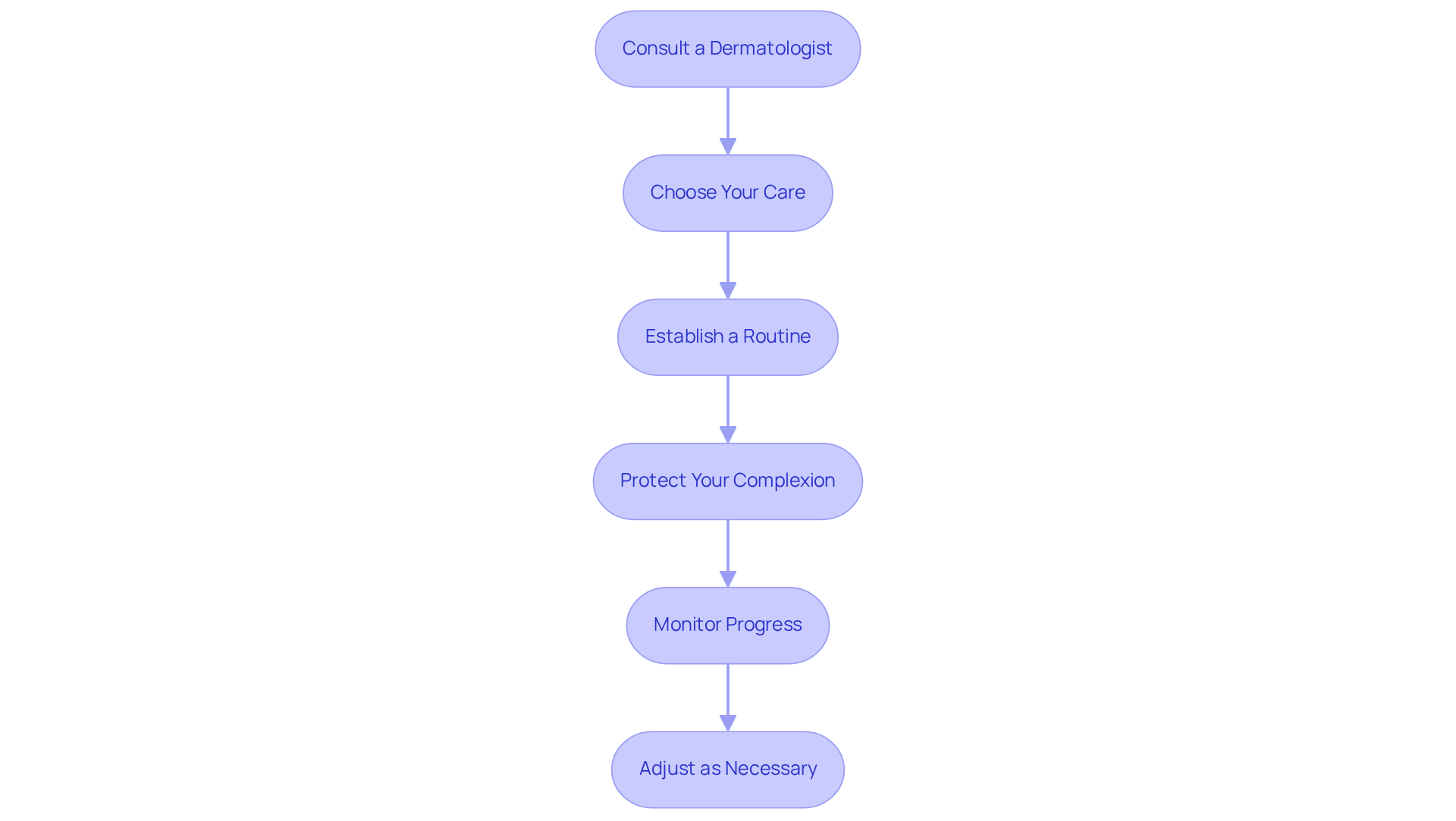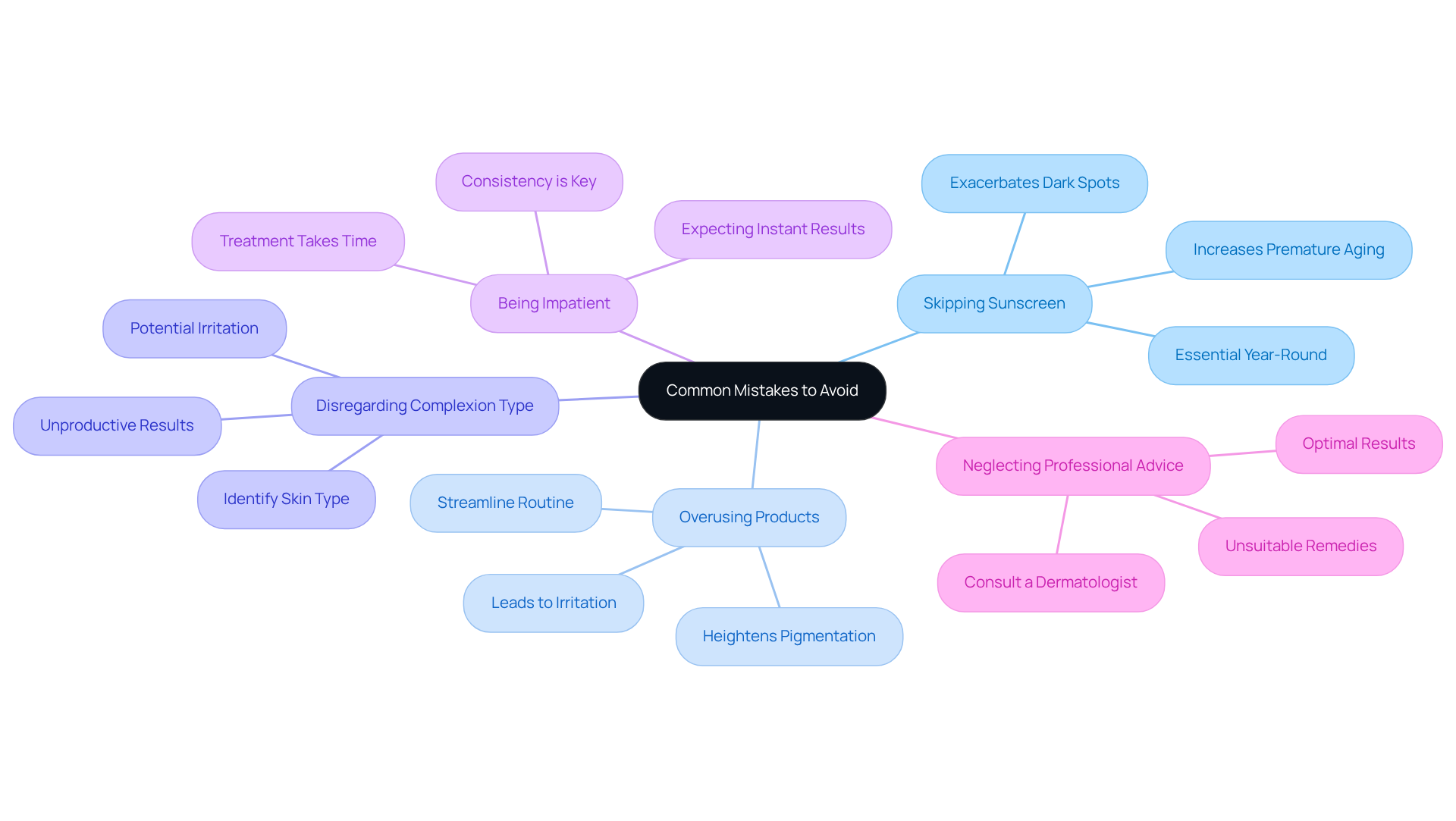How to Get Rid of Dark Spots on Face: A Step-by-Step Plan

Overview
To effectively eliminate dark spots on the face, a comprehensive step-by-step plan is essential. This plan includes:
- Consulting a dermatologist
- Selecting appropriate treatments
- Maintaining a consistent skincare routine that emphasizes sun protection
Various treatment options, such as:
- Topical creams
- Chemical peels
- Laser therapy
are available. It is crucial to avoid common mistakes like skipping sunscreen and overusing products, as these can significantly hinder progress. By adhering to this structured approach, individuals can achieve clearer, healthier skin.
Introduction
Dark spots on the face often lead to frustration and self-consciousness, arising from various causes such as sun exposure, hormonal changes, and aging. Recognizing these underlying factors is crucial for anyone determined to reclaim their skin's clarity and confidence.
With a multitude of treatment options available—ranging from topical solutions to professional therapies—navigating this complex landscape can seem daunting.
This guide presents a step-by-step plan to eliminate dark spots, addressing common pitfalls along the way, and empowering individuals to achieve a brighter, more even complexion.
Understand the Causes of Dark Spots on the Face
Dark spots, commonly known as hyperpigmentation, can arise from several critical factors that warrant attention:
- Sun Exposure: Prolonged exposure to ultraviolet (UV) rays significantly elevates melanin production, resulting in the formation of dark spots. Research indicates that UV light is a primary contributor to pigmentation changes, underscoring the necessity of sun protection. Daily application of broad-spectrum sunscreen with a minimum SPF of 30 is essential to safeguard against UV damage.
- Hormonal Changes: Conditions such as pregnancy or the use of hormonal treatments can trigger melasma, a specific type of dark mark characterized by brown patches on the skin's surface.
- Aging: As the skin matures, cumulative sun exposure over the years often leads to age spots, which are flat, oval areas of increased pigmentation typically found on sun-exposed areas. These age marks can range in size from that of a freckle to approximately 1/2 inch (13 millimeters) in diameter.
- Dermal Injuries: Post-inflammatory hyperpigmentation can manifest following dermal injuries, such as acne or cuts, where the skin darkens during the healing process.
- Medications: Certain medications may increase sensitivity to sunlight, thereby elevating the risk of developing pigmentation.
- Genetic Factors: Advances in genetic testing, including Geneus DNA testing, enable individuals to evaluate their susceptibility to hyperpigmentation by analyzing specific genes like MC1R, IRF4, and SLC45A2, which are involved in melanin production and UV sensitivity.
Understanding these factors is crucial for assessing your skin condition and selecting the most . Given that hyperpigmentation is prevalent among adults, particularly those over 50, awareness of these elements empowers individuals to adopt proactive measures in their skincare routines. It is also important to recognize that hyperpigmentation can impact self-esteem, making it vital to address both the physical and emotional dimensions of the condition.

Explore Treatment Options for Dark Spots
A variety of effective treatment options exist for how to get rid of dark spots on face, each offering unique benefits that can significantly enhance your skin's appearance.
Topical Treatments: Creams formulated with hydroquinone, retinoids, vitamin C, and niacinamide are widely recognized for their ability to gradually lighten dark spots. Hydroquinone, in particular, is often considered a first-line therapy for conditions like melasma and post-inflammatory hyperpigmentation (PIH). However, it is essential to use it under professional supervision due to potential side effects, including irritation and the risk of ochronosis. The maximum suggested length of hydroquinone application is six months.
Chemical Peels: These procedures involve applying a chemical solution to the surface, exfoliating the outer layers and promoting new cell growth. Research suggests that chemical peels can greatly enhance hyperpigmentation, with success rates differing according to the type of peel employed and personal dermal response. Glycolic acid peels, along with other alpha hydroxy acids like lactic acid and beta hydroxy acids such as salicylic acid, are known for their effectiveness in treating melasma and sun damage.
Laser Therapy: Laser treatments provide an accurate approach for targeting blemishes by breaking down melanin and encouraging a uniform complexion. Technologies like Q-switched lasers and picosecond lasers are favored for their advantageous side effect profiles, particularly in individuals with deeper complexions. Studies have shown that laser therapy can yield impressive results, often requiring a series of sessions for optimal outcomes.
Microdermabrasion: This procedure gently exfoliates the outer layer of the epidermis, which is a method for how to get rid of dark spots on face. While , it may not be appropriate for all types of complexions, and outcomes can differ.
Natural Remedies: Ingredients like lemon juice, aloe vera, and green tea extract are often touted for their mild lightening effects. Nevertheless, the effectiveness of these natural treatments can be variable, and they should be applied with care to prevent irritation. It is also important to note that daily sunscreen use is critical in preventing further hyperpigmentation.
Consulting with a dermatologist is crucial for understanding how to get rid of dark spots on face while developing a personalized treatment plan that considers your specific skin type and concerns. This expert advice guarantees that you select the most efficient and secure choices for handling blemishes.

Implement a Step-by-Step Treatment Plan
To effectively treat dark spots, it is essential to follow a systematic plan on how to for optimal results.
- Consult a Dermatologist: Begin by scheduling an appointment to discuss your specific concerns. This step ensures you receive personalized recommendations tailored to your skin type.
- Choose Your Care: Based on the insights gained from your consultation, select a care option that aligns with your complexion and lifestyle preferences.
- Establish a Routine: Integrate your chosen topical applications into your daily skincare regimen. Consistency is key; use these products as instructed to maximize their effectiveness.
- Protect Your Complexion: Daily application of a broad-spectrum sunscreen is crucial. This not only prevents further darkening of existing spots but also shields your skin from harmful UV rays.
- Monitor Progress: Regularly track changes in your skin over time. Note any improvements or reactions to the therapies you are implementing, as this information is valuable for your ongoing care.
- Adjust as Necessary: If you do not observe results within a few weeks, consult your dermatologist to reassess and modify your care plan accordingly.
By adhering to these structured steps, you can establish a methodical approach to understanding how to get rid of dark spots on face efficiently.

Identify Common Mistakes and Things to Avoid
To maximize the effectiveness of your treatment for , it is crucial to avoid common mistakes that can hinder your progress.
- Skipping Sunscreen: Neglecting sun protection can significantly exacerbate dark spots and undermine treatment efforts. Daily sunscreen use is essential, as UV exposure is a leading cause of pigmentation issues and premature aging. Research shows that neglecting to use sunscreen speeds up damage to the outer layer, making it essential to apply a broad-spectrum SPF of at least 30 each morning. As stated by the Skin Cancer Foundation, "Daily sunscreen application is crucial to avoid premature aging and lower the risk of cancer." Remember, UV rays can affect your skin throughout the year, even on rainy days, so it's essential to know how to get rid of dark spots on face.
- Overusing Products: Applying excessive products or using them too frequently can lead to irritation, resulting in heightened pigmentation and negative reactions. In fact, research indicates that 62% of individuals use more than the recommended amount of skincare products. Streamlining your routine to focus on a select few high-quality products suited to your complexion can significantly enhance effectiveness.
- Disregarding Complexion Type: Utilizing remedies that are not appropriate for your specific complexion can lead to unproductive results and potential irritation. It is essential to identify your skin type and select products accordingly, concentrating on ingredients that cater to your unique needs.
- Being Impatient: Dark spots require time to diminish, and expecting instant results can lead to disappointment and hasty cessation of treatment. Consistency is key; many therapies necessitate several weeks to demonstrate noticeable progress.
- Neglecting Professional Advice: Failing to consult with a dermatologist can result in the selection of unsuitable remedies that may not effectively address your specific concerns. Professional guidance ensures that you are using the right products and techniques for optimal results.
By being mindful of these common pitfalls, you can enhance your treatment journey and understand how to get rid of dark spots on face more effectively.

Conclusion
Effectively addressing dark spots on the face requires a deep understanding of their underlying causes and the implementation of a comprehensive treatment plan. By gaining insights into factors such as sun exposure, hormonal changes, and aging, individuals can make informed decisions to combat hyperpigmentation. This journey towards clearer skin transcends mere appearance; it significantly enhances confidence and self-esteem.
The article delineates various treatment options, including:
- Topical treatments
- Chemical peels
- Laser therapy
- Natural remedies
Each offering distinct benefits. A systematic approach is crucial, commencing with a consultation with a dermatologist to tailor a regimen that aligns with individual skin types and concerns. Consistency in applying chosen treatments and utilizing daily sunscreen is vital for achieving and maintaining results. Furthermore, avoiding common pitfalls—such as neglecting sun protection and overusing products—can markedly enhance the efficacy of the treatment plan.
Ultimately, tackling dark spots on the face is a multifaceted endeavor that demands patience and diligence. By embracing a well-structured skincare routine and seeking professional guidance, individuals can take proactive steps towards healthier, more radiant skin. The commitment to understanding and treating hyperpigmentation not only bolsters skin health but also empowers individuals to feel confident in their own skin.
Frequently Asked Questions
What are dark spots on the face commonly known as?
Dark spots on the face are commonly known as hyperpigmentation.
What are the main causes of dark spots?
The main causes of dark spots include sun exposure, hormonal changes, aging, dermal injuries, certain medications, and genetic factors.
How does sun exposure contribute to dark spots?
Prolonged exposure to ultraviolet (UV) rays significantly increases melanin production, leading to the formation of dark spots. It is essential to apply broad-spectrum sunscreen with a minimum SPF of 30 to protect against UV damage.
What role do hormonal changes play in the development of dark spots?
Hormonal changes, such as those occurring during pregnancy or from hormonal treatments, can trigger melasma, which is characterized by brown patches on the skin's surface.
How does aging affect the skin in relation to dark spots?
As the skin matures, cumulative sun exposure can lead to age spots, which are flat, oval areas of increased pigmentation typically found on sun-exposed areas. These spots can vary in size.
What is post-inflammatory hyperpigmentation?
Post-inflammatory hyperpigmentation occurs when the skin darkens during the healing process following dermal injuries, such as acne or cuts.
Can medications influence the development of dark spots?
Yes, certain medications can increase sensitivity to sunlight, raising the risk of developing pigmentation.
How can genetic factors affect susceptibility to hyperpigmentation?
Genetic testing, such as Geneus DNA testing, can help individuals assess their susceptibility to hyperpigmentation by analyzing specific genes involved in melanin production and UV sensitivity.
Why is it important to understand the causes of dark spots?
Understanding the causes of dark spots is crucial for assessing skin conditions and selecting effective treatment options, as hyperpigmentation is prevalent among adults, especially those over 50.
How can hyperpigmentation impact individuals emotionally?
Hyperpigmentation can affect self-esteem, making it important to address both the physical and emotional aspects of the condition.


